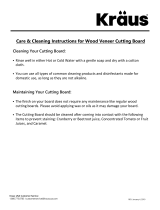
4
DISPOSAL OF ASHES
Ashes should be placed in a metal container with a tight-fitting lid. The closed container of ashes should be placed on a non-
combustible floor or on the ground, well away from all combustible materials, pending final disposal. When ashes are disposed by
burial in soil, or otherwise locally dispersed, they should be retained in a closed container until all cinders have thoroughly cooled.
WOOD PELLET FUEL
This pellet cooking appliance is designed and approved for pelletized, all natural, wood fuel only. Any other type of fuel burned
in this appliance will void the warranty and safety warning. You must only use all natural wood pellets, designed for burning in
pellet barbecue smokers. Do not use fuel labelled as having additives.
Do not use lava rock, wood chunks, charcoal, spirit, petrol, gasoline, lighter-fluid or kerosene for lighting or
refreshing a fire in your smoker. Keep all such substances and liquids well away from appliance when in use.
At this time of printing, there is no industry standard for barbecue wood pellets, although most pellet mills use the same standards
to make wood pellets for domestic use. Further information, can be found at
www.pelletheat.org
or the
Pellet Fuel Institute
.
Contact your local dealer on the quality of pellets in your area, and for information on brand quality. As there is no control over
the quality of pellets used with the appliance, Dansons Inc. assumes no liability caused by the quality of fuel.
CREOSOTE
Creosote, or soot, is a tar-like substance. When burning, it produces black smoke with a residue which is also black in color. Soot
or creosote is formed when the appliance is operated incorrectly, such as: blockage of the burn pot, blockage of the combustion
fan, failure to clean and maintain the burn area, or poor air-to-fuel combustion.
It is dangerous to operate this appliance should the flame become dark, sooty, or if the burn pot is overfilled with pellets. When
ignited, this creosote makes an extremely hot and uncontrolled fire, similar to a grease fire. Should this happen, turn the unit off,
let it cool completely, then inspect for maintenance and cleaning. It commonly accumulates along exhaust areas.
If creosote has formed within the unit; allow the unit to warm up at a low temperature, turn off the appliance, then wipe away
any formation with a hand towel. Similar to tar, it is much easier to clean when warm, as it becomes liquid.
CARBON MONOXIDE (“ ”)
Carbon monoxide is a colorless, odorless, tasteless gas produced by burning gas, wood, propane, charcoal or other fuel. Carbon
monoxide reduces the blood’s ability to carry oxygen. Low blood oxygen levels can result in headaches, dizziness, weakness,
nausea, vomiting, sleepiness, confusion, loss of consciousness or death. Follow these guidelines to prevent this colorless, odorless
gas from poisoning you, your family, or others:
• See a doctor if you or others develop cold or flu-like symptoms while cooking or in the vicinity of the appliance. Carbon
monoxide poisoning, which can easily be mistaken for a cold or flu, is often detected too late.
• Alcohol consumption and drug use increase the effects of carbon monoxide poisoning.
• Carbon monoxide is especially toxic to mother and child during pregnancy, infants, the elderly, smokers, and people with
blood or circulatory system problems, such as anemia, or heart disease.
SAFETY LISTING
In accordance with the procedures and specifications listed in the UL Subject 2728-2009 "pellet fuel
cooking appliances" and / 272 and Canadian 22.2 #3 "for electrical features of fuel
burning equipment." Pit Boss Grills pellet cooking appliances have been independently tested and
listed by Intertek (an accredited testing laboratory) to , , and standards.
This product has been assessed and meets EU (European Economic Area) safety, health and environmental
protection requirements. Please read the silver safety label found on the back of the unit.






























